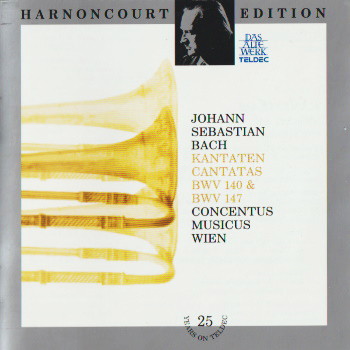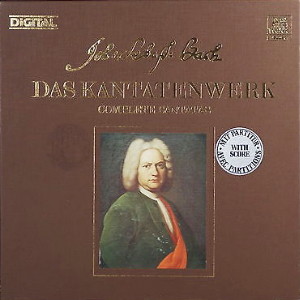 |
1 CD -
Teldec 8.43203 XH (c) 1989
|
 |
| 2 LP's -
Tedec 6.35653 EX (p) 1984 |
 |
| 2 LP's -
Tedec 6.35654 EX (p) 1985 |
|
| NIKOLAUS HARNONCOURT - 25 Years
on TELDEC |
|
|
|
|
|
|
|
| Johann Sebastian
Bach (1685-1750) |
Kantaten · Cantatas ·
Cantates |
|
|
|
|
|
|
|
|
|
Kantate "Wachet auf,
ruft uns die Stimme", BWV 140 |
|
28' 24" |
|
|
Solo:
Sopran, Tenor, Baß - Chor |
|
|
|
|
Corno
(Zink); Oboe I, II, Taille (Oboe da
caccia in F); Violino piccolo;
Streicher, Basso continuo (Fagotto,
Violoncello, Violone, Organo) |
|
|
|
|
-
Choral "Wachet
auf, ruft uns die Stimme" |
7' 11"
|
|
|
|
-
Recitativo (Tenore) "Er
kommt, der Bräutigam kommt" |
0' 57"
|
|
|
|
- Aria,
Duetto (Soprano, Basso) "Wann
kommst du, mein Heil" |
6' 32"
|
|
|
|
-
Choral Tenore) "Zion
hört die Wächter singen" |
3' 58"
|
|
|
|
-
Recitativo (Tenore) "So geh
herein zu mir" |
1' 37"
|
|
|
|
- Aria,
Duetto (Soprano, Basso) "Mein
Freund ist mein, und ich bin sein" |
6' 22"
|
|
|
|
-
Choral "Gloria
sei dir gesungen" |
1' 47"
|
|
|
|
|
|
|
|
|
Kantate "Herz und Mund
und Tat und Leben", BWV 147 |
|
31' 31" |
|
|
Solo:
Sopran, Alt, Tenor, Baß - Chor |
|
|
|
|
Tromba
(Naturtrompete in C, Zugtrompete
(6,10)); Oboe I, II; Oboe d'amore;
Streicher; Basso continuo (Fagotto,
Violoncello, Violone, Organo) |
|
|
|
|
Prima
Parte |
|
|
|
|
- Chor "Herz
und Mund und Tat und Leben" |
4' 49" |
|
|
|
-
Recitativo (Tenore) "Gebenedeiter
Mund" |
2' 14" |
|
|
|
- Aria
(Alto) "Schäme
dich, o Seele, nicht" |
4' 04" |
|
|
|
-
Recitativo (Basso) "Verstockung
kann Gewaltige verblenden" |
1' 40" |
|
|
|
- Aria
(Soprano) "Bereite
dir, Jesu, noch itzo die Bahn" |
5' 02" |
|
|
|
-
Choral "Wohl
mir, daß ich Jesum habe" |
2' 39" |
|
|
|
Seconda
Parte |
|
|
|
|
- Aria
(Tenore) "Hilf,
Jesu, hilf" |
3' 24" |
|
|
|
-
Recitativo (Alto) "Der
höchsten Allmacht Wunderband" |
2' 24" |
|
|
|
- Aria
(Basso) "Ich
will von Jesu Wundern singen" |
2' 37" |
|
|
|
-
Choral "Jesus
bleibet meine Freude" |
2' 38" |
|
|
|
|
|
|
|
BWV 140
|
BWV 147
|
|
|
|
|
| Alan
Bergius (Tölzer
Knabenchores), Sopran |
Alan
Bergius (Tölzer
Knabenchores), Sopran |
|
| Kurt
Equiluz, Tenor |
Stefan
Rampf (Tölzer
Knabenchores), Sopran |
|
| Thomas
Hampson, Basso |
Paul
Esswood, Alt |
|
| Tölzer
Knabenchor /
Gerhard Schmidt-Gaden, Chorleitung |
Kurt
Equiluz, Tenor |
|
| CONCENTUS MUSICUS
WIEN (mit Originainstrumenten) |
Thomas Hapson, Basso |
|
| Nikolaus
HARNONCOURT, Leitung |
Tölzer
Knabenchor /
Gerhard Schmidt-Gaden, Chorleitung |
|
|
CONCENTUS MUSICUS
WIEN (mit Originainstrumenten) |
|
|
Nikolaus
HARNONCOURT, Leitung |
|
|
|
|
|
Luogo
e data di registrazione |
|
Casino
Zögernitz, Vienna (Austria):
- novembre 1981, gennaio 1983 (BWV
140)
- novembre 1981, gennaio 1982,
gennaio e marzo 1983 (BWV 147) |
|
|
Registrazione:
live / studio |
|
studio |
|
|
Producer
|
|
- |
|
|
Edizione CD |
|
TELDEC
- 8.43203 XH (243 109-2) - (1 CD -
durata 59' 55") - (c) 1989 - DDD |
|
|
Originale LP
|
|
TELDEC
"Kantatenwerk, vol.35" - 6.35653
EX - (2 LP's - durata 55' 21"
& 47' 40") - (p) 1984 -
Digitale (BWV 140, LP 1/a)
TELDEC "Kantatenwerk, vol.36" -
6.35654 EX - (2 LP's - durata 49'
24" & 51' 33") - (p) 1985 -
Digitale (BWV 147, LP 1/a)
|
|
|
Note |
|
-
|
|
|
|
|
Wachet auf, ruft uns
die Stimme (BWV
140), based on a hymn by
Philipp Nicolai, was written for
the 27th Sunday after Trinity,
which only occurs in the
liturgical year if Easter falls
before March 27.
During the time that Bach spent
at Leipzig this Sunday fell on
November 25, 1731 (for
which the cantata was composed)
and occurred again in 1742. The
hymn’s three long stanzas and
expansive melodic line, and also
the concept of Jesus’ love,
with the faithful soul as his
bride, inspired Bach to an
exceptionally grand design. The
three stanzas constitute the
beginning, middle and end,
interspersed by two recitatives
and two duets (called ”arias”)
for which an anonymous
librettist made extensive use of
bible quotations,
particularly from the Song
of Songs. In the great
opening chorus, accompanied by
oboes and strings, the
lines of text and the orchestral
interludes are arranged,
somewhat in the manner of
a chorale prelude, into
seven sections, corresponding to
the seven movements of the whole
cantata. The twelve knocks
(dotted notes) in the first four
bars, repeated several times,
probably symbolise the
midnight bell. The other choral
parts and the motivic work in
the orchestra have been evolved
from the hymn tune. The
recitative (No. 2) "Er
komnrt, der Bräutgam kommt” is
followed by a duet (No. 3) in
which Jesus appears as the
bridegroom of the soul,
represented as one of the "wise
virgins.” The violino piccolo,
tuned a third higher, endows
this duet with special
brilliance. The accompanied
recitative (No. 5) describes the
bridegroom, Jesus, taking
his bride unto hirnself. Unusual
harmonies introduce the second
duet in which heavenly and
earthly love merge into one,
Like No. 3 it is one of the most
beautiful love duets ever
written, almost ardent yet
relaxed and dancelike,
while No. 3 is yearning and
mystical. Equidistant between
the great opening chorus and the
final chorale, where the violino
piccolo imparts splendour to
this ”sacred bridal song”
(Philipp Nicolai’s title), there
is a three-part chorale concerto
(No. 4). The unison strings and
the continuo bass play an
instruntental piece into which
the hymn stanza is interwoven
line by line. Bach transposed
this movement for the organ (BWV
645) and placed it at the
beginning of the Schübler
Chorales. The unity of the work
is based on the way in which its
form is conceived, and also on
the fact that its most important
motifs are derived from the hymn
tune.
··········
Herz und
Mund und Tat und Leben
(BWV 147) was written
in its present form for the
Feast of the Visitation of
Mary (July 2) in the
year 1723. Bach had started
working on this cantata in
Weimar for the Fourth Sunday in
Advent 1716, but evidently never
completed it. In Leipzig
no cantatas were sung on
that Sunday, but the passage
from the Bible on which this
work is based contains the
Magnificat and is therefore
quite appropriate for a
Marian feast day. Rearrangements
of the text, additional
recltatives and an
interpolated chorale stanza
(No. 6) produced a cantata
in two parts, the inclusion
of a trumpet in the
otherwise
traditional scoring
imparting a festive
splendour to the work. The
opening chorus, the introduction
to which is repeated at the end,
is in three parts with fugal
outer sections. The tenor
recitative is followed by an
aria for alto (Mary) with a
strangely indeterminate rhythm
that erratically changes from
3/4 time to an implied 3/2 time.
This feature derives from a
notion current in the late
Middle Ages according to which
triple rhythm (but not triple
time) was a symbol of the
Trinity and thus the musical
expression of
perfection. In this context
the oboe represents the
supernatural, while the solo
violin in the soprano aria (No.
5) represents Jesus, the
Son of Man. The instrumental
symbolism is quite obvious from
the text. The two chorale
stanzas which conclude the
sections before and after
the sermon are characterised by
an independent orchestral
accompaniment which also serves
as a prelude and has been
popularised under the name
of "Jesu, joy
of Man’s desiring." The
dotted notes and triplets, a
feature in organ chorales which
often symbolises the joy of
Christmas, forge the link with
the festive season. The second
part opens with a tenor aria in
which the vocal line is based on
the phrase ”Hilf, Jesu,
hilf” (Help, Jesus); quite
exceptionally the cello and
organo in the continue are not
kept in unison, the organo
playing the decorated line. An
expressive alto recitative with
two oboes da caccia is followed
by a bass aria in which for the
first time a solo part is
accompanied by the whole
orchestra. The words “Ich will
von Jesu Wundern singen”
(”Of Jesus
am I ever singing";
some editions still print the
older version in which "Wunder”
- marvels - is replaced by
"Wunden” - wounds) are
eloquently painted by the many
coloratura passages.
Gerhard
Schuhmacher
|
|

